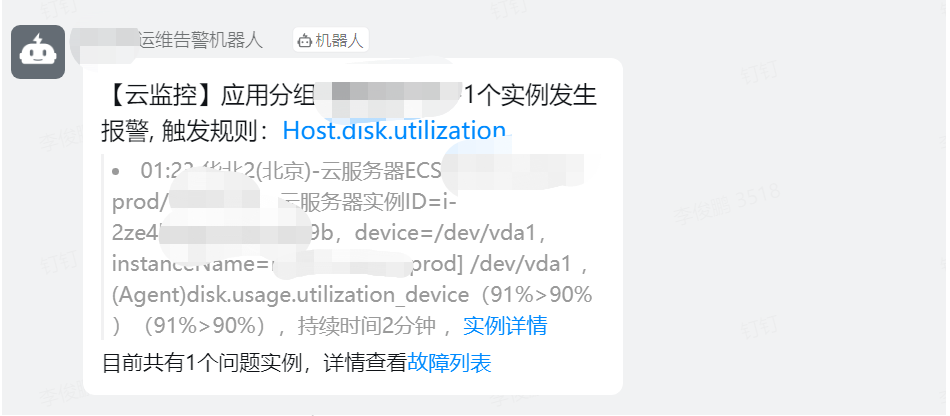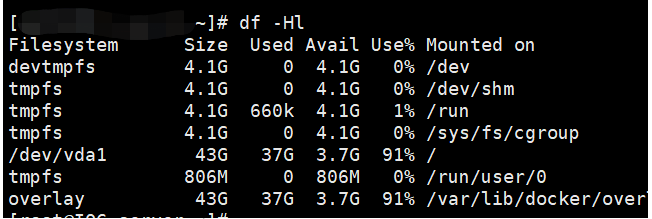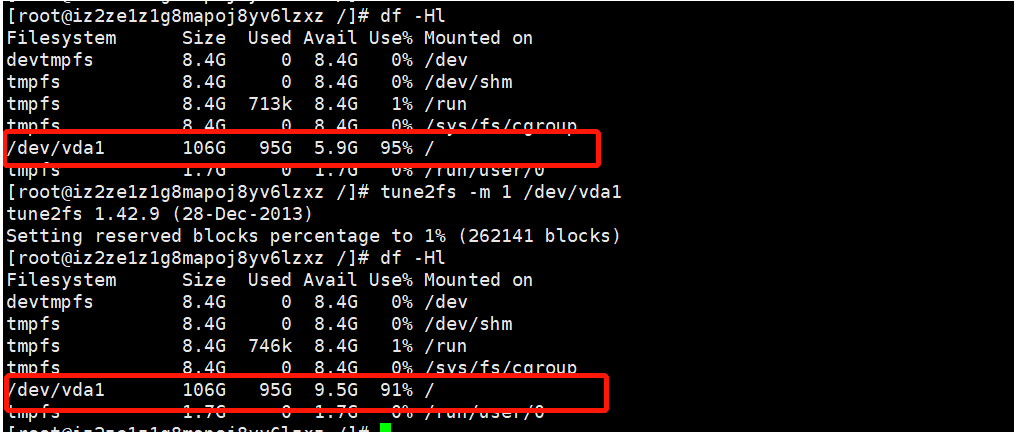Linux disk space is abnormally full, how to check?
During the server operation and maintenance process, we often encounter such a situation and receive a server disk space alarm: <br>

Log in to the server and view it through df -Hl

is consistent with the alarm information. Then we need to find the directory or file that causes the disk space to become full.
How to find directories or files that take up a lot of space?
A relatively stupid method is to use the du -hs command in the root directory to list the space occupied by each directory

Then use the same method to continue to the corresponding directory to find
A more efficient method is to set the directory depth of the query through the -d parameter of du, or -max-depth. As the directory depth increases, a lot of the queried directories will be displayed. At this time, you can filter through grep. .
du -h -d 2|grep [GT] |sort -nr du -h --max-depth=2|grep [GT] |sort -nr
In this way, you can search for large directories that occupy disk space in units of G or T and sort them
Or you can query it through find
find / -type f -size +1G -exec du -h {} \;
In terms of efficiency, find is faster and more flexible than du.
Through these two methods, we can quickly find the culprit taking up disk space.
Do you think it’s that simple? Many times, you will find that after searching for a long time through find or du, you will find that the total occupied space is very different from the disk space occupied by df, such as the two pictures above.
Viewed through df, the disk usage is 37G, but viewed through du -hs in the root directory, the total adds up to almost 10G, there is no hidden directory, who is eating the space?
Obviously, there is space occupied by deleted files. The files are deleted, but the resources are not released.
I introduced a very useful command before: lsof, we can check it through the following command
lsof +L1

It can be seen from the results that there is a large log file of about 28G. It was deleted, but the space was not released. This is a very common situation.
The corresponding solution is to restart the tomcat application and free up space
Disk space is being eaten up for no reason?
There is another question that is often asked, that is, the disk viewed through df

You will find that the sum of Used and Avail is not enough for Size, and part of it is eaten inexplicably
In fact, this is a security policy of the Linux file system. By default, it will reserve 5% of the disk space for the root user for emergency use. This can ensure that some key applications (such as databases) have some leeway when the hard disk is full, so that they will not crash immediately
We can modify the ratio of reserved space through tune2fs
tune2fs -m 1 /dev/vda1
You can see the before and after comparison through the picture below

The space that was eaten up in this way is released!
The above is the detailed content of Linux disk space is abnormally full, how to check?. For more information, please follow other related articles on the PHP Chinese website!

Hot AI Tools

Undresser.AI Undress
AI-powered app for creating realistic nude photos

AI Clothes Remover
Online AI tool for removing clothes from photos.

Undress AI Tool
Undress images for free

Clothoff.io
AI clothes remover

Video Face Swap
Swap faces in any video effortlessly with our completely free AI face swap tool!

Hot Article

Hot Tools

Notepad++7.3.1
Easy-to-use and free code editor

SublimeText3 Chinese version
Chinese version, very easy to use

Zend Studio 13.0.1
Powerful PHP integrated development environment

Dreamweaver CS6
Visual web development tools

SublimeText3 Mac version
God-level code editing software (SublimeText3)

Hot Topics
 1664
1664
 14
14
 1422
1422
 52
52
 1316
1316
 25
25
 1266
1266
 29
29
 1239
1239
 24
24
 Linux Architecture: Unveiling the 5 Basic Components
Apr 20, 2025 am 12:04 AM
Linux Architecture: Unveiling the 5 Basic Components
Apr 20, 2025 am 12:04 AM
The five basic components of the Linux system are: 1. Kernel, 2. System library, 3. System utilities, 4. Graphical user interface, 5. Applications. The kernel manages hardware resources, the system library provides precompiled functions, system utilities are used for system management, the GUI provides visual interaction, and applications use these components to implement functions.
 How to check the warehouse address of git
Apr 17, 2025 pm 01:54 PM
How to check the warehouse address of git
Apr 17, 2025 pm 01:54 PM
To view the Git repository address, perform the following steps: 1. Open the command line and navigate to the repository directory; 2. Run the "git remote -v" command; 3. View the repository name in the output and its corresponding address.
 How to run java code in notepad
Apr 16, 2025 pm 07:39 PM
How to run java code in notepad
Apr 16, 2025 pm 07:39 PM
Although Notepad cannot run Java code directly, it can be achieved by using other tools: using the command line compiler (javac) to generate a bytecode file (filename.class). Use the Java interpreter (java) to interpret bytecode, execute the code, and output the result.
 What is the main purpose of Linux?
Apr 16, 2025 am 12:19 AM
What is the main purpose of Linux?
Apr 16, 2025 am 12:19 AM
The main uses of Linux include: 1. Server operating system, 2. Embedded system, 3. Desktop operating system, 4. Development and testing environment. Linux excels in these areas, providing stability, security and efficient development tools.
 How to run sublime after writing the code
Apr 16, 2025 am 08:51 AM
How to run sublime after writing the code
Apr 16, 2025 am 08:51 AM
There are six ways to run code in Sublime: through hotkeys, menus, build systems, command lines, set default build systems, and custom build commands, and run individual files/projects by right-clicking on projects/files. The build system availability depends on the installation of Sublime Text.
 laravel installation code
Apr 18, 2025 pm 12:30 PM
laravel installation code
Apr 18, 2025 pm 12:30 PM
To install Laravel, follow these steps in sequence: Install Composer (for macOS/Linux and Windows) Install Laravel Installer Create a new project Start Service Access Application (URL: http://127.0.0.1:8000) Set up the database connection (if required)
 git software installation
Apr 17, 2025 am 11:57 AM
git software installation
Apr 17, 2025 am 11:57 AM
Installing Git software includes the following steps: Download the installation package and run the installation package to verify the installation configuration Git installation Git Bash (Windows only)
 How to use VSCode
Apr 15, 2025 pm 11:21 PM
How to use VSCode
Apr 15, 2025 pm 11:21 PM
Visual Studio Code (VSCode) is a cross-platform, open source and free code editor developed by Microsoft. It is known for its lightweight, scalability and support for a wide range of programming languages. To install VSCode, please visit the official website to download and run the installer. When using VSCode, you can create new projects, edit code, debug code, navigate projects, expand VSCode, and manage settings. VSCode is available for Windows, macOS, and Linux, supports multiple programming languages and provides various extensions through Marketplace. Its advantages include lightweight, scalability, extensive language support, rich features and version




